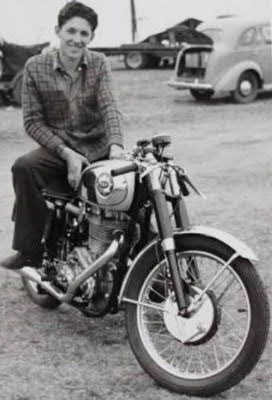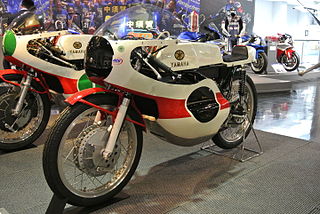
Grand Prix motorcycle racing is the highest class of motorcycle road racing events held on road circuits sanctioned by the Fédération Internationale de Motocyclisme (FIM). Independent motorcycle racing events have been held since the start of the twentieth century and large national events were often given the title Grand Prix. The foundation of the Fédération Internationale de Motocyclisme as the international governing body for motorcycle sport in 1949 provided the opportunity to coordinate rules and regulations in order that selected events could count towards official World Championships. It is the oldest established motorsport world championship.

The Ducati Desmosedici is a four-stroke V4 engine racing motorcycle made by Ducati for MotoGP racing. The series nomenclature is GP with the two-digit year appended, such as Desmosedici GP10 for 2010. In 2006 Ducati made a short production run of 1,500 street-legal variants, the Desmosedici RR.

Randy Mamola is an American former professional motorcycle racer and television sports presenter. He competed in Grand Prix motorcycle racing between 1979 and 1992. A 13-time Premier Class race winner, Mamola was one of the most charismatic Grand Prix road racers of his generation, becoming a favourite because of his interaction with race fans both on and off the track as well as his aggressive and spirited riding style.

Phillip William Read, was an English professional motorcycle racer. He competed in Grand Prix motorcycle racing from 1961 to 1976. Read is notable for being the first competitor to win world championships in the 125 cc, 250 cc and 500 cc classes. Although he was often overshadowed by his contemporary, Mike Hailwood, he won seven FIM Grand Prix road racing world championships.
The 1972 Grand Prix motorcycle racing season was the 24th F.I.M. Road Racing World Championship Grand Prix season. The season consisted of twelve Grand Prix races in six classes: 500cc, 350cc, 250cc, 125cc, 50cc and Sidecars 500cc. It began on 30 April, with West German Grand Prix and ended with Spanish Grand Prix on 23 September.

The large majority of works racing motorcycles manufactured by the motorcycle racing division of Honda of Japan, currently called Honda Racing Corporation, carry the iconic prefix RC.

The 1964 Grand Prix motorcycle racing season was the 16th F.I.M. Road Racing World Championship Grand Prix season. The season consisted of twelve Grand Prix races in six classes: 500cc, 350cc, 250cc, 125cc, 50cc and Sidecars 500cc. It began on 2 February, with United States Grand Prix and ended with Japanese Grand Prix on 1 November.

Luigi Taveri was a Swiss professional Grand Prix motorcycle road racer. He competed in the FIM motorcycle Grand Prix world championships from 1954 to 1966. Taveri is notable for being a three-time 125cc road racing world champion. Although he specialised in the smaller engined machines, Taveri is the only competitor to have scored points in six Grand Prix classes: 50cc, 125cc, 250cc, 350cc, 500cc and Sidecars. In 2016, he was named an FIM Legend for his motorcycling achievements.
The 1965 Grand Prix motorcycle racing season was the 17th F.I.M. Road Racing World Championship Grand Prix season. The season consisted of thirteen Grand Prix races in six classes: 500cc, 350cc, 250cc, 125cc, 50cc and Sidecars 500cc. It began on 21 March, with United States Grand Prix and ended with Japanese Grand Prix on October, 24.
The 1966 Grand Prix motorcycle racing season was the 18th F.I.M. Road Racing World Championship Grand Prix season. The season consisted of twelve Grand Prix races in six classes: 500cc, 350cc, 250cc, 125cc, 50cc and Sidecars 500cc. It began on 8 May, with Spanish Grand Prix and ended with Japanese Grand Prix on 17 October.

William David Ivy was an English professional Grand Prix motorcycle racer from Maidstone, Kent. He died during practice for a race in East Germany.

The 1970 Grand Prix motorcycle racing season was the 22nd F.I.M. Road Racing World Championship Grand Prix season. The season consisted of twelve Grand Prix races in six classes: 500cc, 350cc, 250cc, 125cc, 50cc and Sidecars 500cc. It began on 3 May, with West German Grand Prix and ended with Spanish Grand Prix on 27 September.

Thomas Edward Phillis was an Australian professional Grand Prix motorcycle road racer. He won the 1961 125cc motorcycle road racing World Championship and was the first person to lap the Isle of Man TT mountain circuit at over 100 mph on a pushrod engined motorcycle. He was also the first person to win a World Championship motorcycle race on a Japanese machine.

The 50 cc class was the ultra-lightweight class in Grand Prix motorcycle racing, and formed part of the Fédération Internationale de Motocyclisme (FIM) World Championships from 1962 until 1983; when the class was replaced by 80 cc.

Jan Huberts was a Grand Prix motorcycle road racer from the Netherlands. He had his best year in 1962 when he won two Grand Prix races and finished the season in third place behind Ernst Degner and Hans-Georg Anscheidt.

The Honda RC143 was the Honda racing team's 125cc Grand Prix motorcycle racer for the 1960 season. That was the first time the Honda team would compete in an entire season's racing. The bike was a major step forward from the previous year's machines, and though still outpaced by its more experienced European rivals, it revealed to seasoned competitors like Luigi Taveri that Honda would quickly become a force to be reckoned with.

The MV Agusta 125 Bialbero was a 125 cc factory racer from the Italian brand MV Agusta, which was used between 1950 and 1960. The machine won 34 GPs, 6 rider's championships and one manufacturer's championship. The machine also won 4 Italian Championships and 10 National Championships in other countries.

Bridgestone motorcycles were a division of the Bridgestone Tire Co. of Kyōbashi, Tokyo, Japan that produced mopeds and motorcycles from 1952 to 1970. Initially producing power assisted bicycles, the division moved on to producing mopeds and then motorcycles. The motorcycles were technologically advanced and powered by two-stroke engines. The high technical specification resulted in the machines being more expensive compared to other manufacturers models. Production was stopped in 1970 to protect the supply of tyres to other manufacturers.

The Yamaha RA97 is a racing motorcycle produced by Yamaha, for the 125cc class of Grand Prix motorcycle racing, in 1966.














